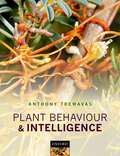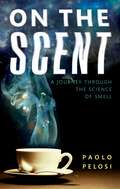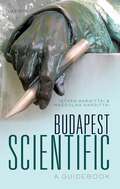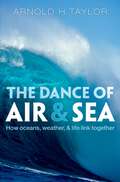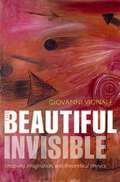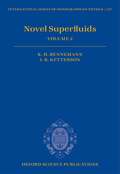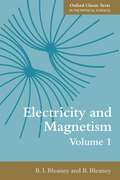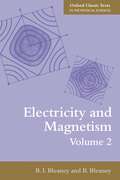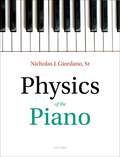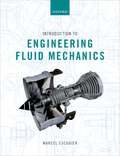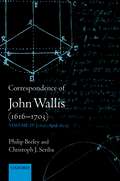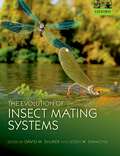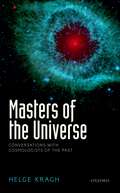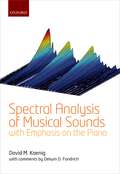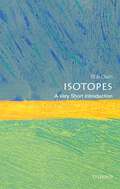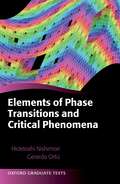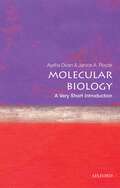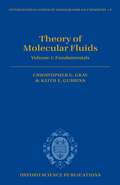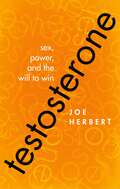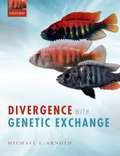- Table View
- List View
Plant Behaviour and Intelligence
by Anthony TrewavasThis book provides a convincing argument for the view that whole cells and whole plants growing in competitive wild conditions show aspects of plant behaviour that can be accurately described as 'intelligent'. Trewavas argues that behaviour, like intelligence, must be assessed within the constraints of the anatomical and physiological framework of the organism in question. The fact that plants do not have centralized nervous systems for example, does not exclude intelligent behaviour. Outside the human dimension, culture is thought largely absent and fitness is the biological property of value. Thus, solving environmental problems that threaten to reduce fitness is another way of viewing intelligent behaviour and has a similar meaning to adaptively variable behaviour. The capacity to solve these problems might be considered to vary in different organisms, but variation does not mean absence. By extending these ideas into a book that allows a critical and amplified discussion, the author hopes to raise an awareness of the concept of purposive behaviour in plants.
Plant Behaviour and Intelligence
by Anthony TrewavasThis book provides a convincing argument for the view that whole cells and whole plants growing in competitive wild conditions show aspects of plant behaviour that can be accurately described as 'intelligent'. Trewavas argues that behaviour, like intelligence, must be assessed within the constraints of the anatomical and physiological framework of the organism in question. The fact that plants do not have centralized nervous systems for example, does not exclude intelligent behaviour. Outside the human dimension, culture is thought largely absent and fitness is the biological property of value. Thus, solving environmental problems that threaten to reduce fitness is another way of viewing intelligent behaviour and has a similar meaning to adaptively variable behaviour. The capacity to solve these problems might be considered to vary in different organisms, but variation does not mean absence. By extending these ideas into a book that allows a critical and amplified discussion, the author hopes to raise an awareness of the concept of purposive behaviour in plants.
On the Scent: A journey through the science of smell
by Paolo PelosiIn humans, the perception of odours adds a fourth dimension to life, from the scent of flowers, the aroma of foods, and all the subtle smells in the environment. But how many types of odours can we distinguish? Why do we like the food we like? Which are the most powerful odorants, and how well does the human sense of smell perform compared with that of a dog or a butterfly? The sense of smell is highly complex, and such complexity discouraged scientists for a long time, leaving the world of smell in an atmosphere of mystery. Only recently, thanks to the new tools furnished by molecular biology and neuroscience, are we beginning to answer these questions, uncovering the hidden secrets of our sense of smell, and decoding the language used by most animals to communicate. In this book, Paolo Pelosi, one of the leading figures in the development of the science of olfaction, recounts how the chemical alphabet behind smell has been pieced together over the past three decades. Drawing on anecdotes from his own scientific career, and celebrating the rich variety of smells from herbs to flowers to roast coffee and freshly baked bread, he weaves together an engaging and remarkable account of the science behind the most elusive of our senses.
On the Scent: A journey through the science of smell
by Paolo PelosiIn humans, the perception of odours adds a fourth dimension to life, from the scent of flowers, the aroma of foods, and all the subtle smells in the environment. But how many types of odours can we distinguish? Why do we like the food we like? Which are the most powerful odorants, and how well does the human sense of smell perform compared with that of a dog or a butterfly? The sense of smell is highly complex, and such complexity discouraged scientists for a long time, leaving the world of smell in an atmosphere of mystery. Only recently, thanks to the new tools furnished by molecular biology and neuroscience, are we beginning to answer these questions, uncovering the hidden secrets of our sense of smell, and decoding the language used by most animals to communicate. In this book, Paolo Pelosi, one of the leading figures in the development of the science of olfaction, recounts how the chemical alphabet behind smell has been pieced together over the past three decades. Drawing on anecdotes from his own scientific career, and celebrating the rich variety of smells from herbs to flowers to roast coffee and freshly baked bread, he weaves together an engaging and remarkable account of the science behind the most elusive of our senses.
Budapest Scientific: A Guidebook
by István Hargittai Magdolna HargittaiThis guidebook introduces the reader to the visible memorabilia of science and scientists in Budapest - statues, busts, plaques, buildings, and other artefacts. According to the Hungarian-American Nobel laureate Albert Szent-Györgyi, this metropolis at the crossroads of Europe has a special atmosphere of respect for science. It has been the venue of numerous scientific achievements and the cradle, literally, of many individuals who in Hungary, and even more beyond its borders, became world-renowned contributors to science and culture. Six of the eight chapters of the book cover the Hungarian Nobel laureates, the Hungarian Academy of Sciences, the university, the medical school, agricultural sciences, and technology and engineering. One chapter is about selected secondary schools from which seven Nobel laureates (Szent-Györgyi, de Hevesy, Wigner, Gabor, Harsanyi, Olah, and Kertész) and the five "Martians of Science" (von Kármán, Szilard, Wigner, von Neumann, and Teller) had graduated. The concluding chapter is devoted to scientist martyrs of the Holocaust. A special feature in surveying Hungarian science is the contributions of scientists that left their homeland before their careers blossomed and made their seminal discoveries elsewhere, especially in Great Britain and the United States. The book covers the memorabilia referring to both émigré scientists and those that remained in Hungary. The discussion is informative and entertaining. The coverage is based on the visible memorabilia, which are not necessarily proportional with achievements. Therefore, there is a caveat that one could not compile a history of science relying solely on the presence of the memorabilia.
The Dance of Air and Sea: How oceans, weather, and life link together
by Arnold H. TaylorHow can the tiny plankton in the sea just off Western Europe be affected by changes 6000 km away on the other side of the North Atlantic Ocean? How can a slight rise in the temperature of the surface of the Pacific Ocean have a devastating impact on amphibian life in Costa Rica? Living populations across the globe are connected by great swayings of the world's atmosphere and oceans, the largest of which is El Nino. For almost half a century, the numbers of some of the smallest animals in the North Sea have gone up and down as the Gulf Stream has moved north and south 4000 miles away at the coast of the USA. This connection has happened because the weather patterns over the North Atlantic are intertwined by a phenomenon first described by a Danish missionary in the eighteenth century, the North Atlantic Oscillation. In The Dance of Air and Sea Arnold Taylor focuses on the large-scale dynamics of the world's climate, looking at how the atmosphere and oceans interact, and the ways in which ecosystems in water and on land respond to changes in weather. He tells stories of how discoveries were made, and the scientists who made them; and he considers the crucial issues of how the discoveries aid our response to global warming.
The Beautiful Invisible: Creativity, imagination, and theoretical physics
by Giovanni VignaleThe realm of theoretical physics is teeming with abstract and beautiful concepts. And the task of imagining them is one that demands profound creativity, argues Giovanni Vignale. Explaining them is curiously akin to the craft of poets, or magical realist novelists such as Borges, and Musil, or Bulgakov's The Master and Margarita. In this unusual and sometimes poetic book, Vignale presents his own unorthodox accounts of fundamental theoretical concepts such as Newtonian mechanics, superconductivity, and Einstein's theory of relativity, showing that what may seem at first quite simple in fact turns out to be much more profound. As we delve behind now-familiar metaphors such as 'electron spin' and 'black hole', the world that we take for granted melts away, leaving a glimpse of something much stranger.
Novel Superfluids: Volume 2 (International Series of Monographs on Physics #157)
by Karl-Heinz Bennemann John B. KettersonVolume 2 of Novel Superfluids continues the presentation of recent results on superfluids, including novel metallic systems, superfluid liquids, and atomic/molecular gases of bosons and fermions, particularly when trapped in optical lattices. Since the discovery of superconductivity (Leyden, 1911), superfluid 4He (Moscow and Cambridge, 1937), superfluid 3He (Cornell, 1972), and observation of Bose-Einstein Condensation (BEC) of a gas (Colorado and MIT, 1995), the phenomenon of superfluidity has remained one of the most important topics in physics. Again and again, novel superfluids yield surprising and interesting behaviors. The many classes of metallic superconductors, including the high temperature perovskite-based oxides, MgB2, organic systems, and Fe-based pnictides, continue to offer challenges. The technical applications grow steadily. What the temperature and field limits are remains illusive. Atomic nuclei, neutron stars and the Universe itself all involve various aspects of superfluidity, and the lessons learned have had a broad impact on physics as a whole.
Electricity and Magnetism, Volume 1 (Oxford Classic Texts in the Physical Sciences)
by B. I. Bleaney B. BleaneyThis book is a reissue of the third and last edition of a classic text providing the reader with a comprehensive account at first degree or introductory graduate level of the principles and experimental aspects of electricity and magnetism, together with an elementary account of the underlying atomic theory. The book is available in a two-volume format. This first volume contains what is needed for a first course in electromagnetism, including electrostatics, electric circuits, magnetism, electromagnetic induction, and electromagnetic waves. SI units are used throughout and there are problems at the end of each chapter.
Electricity and Magnetism, Volume 2 (Oxford Classic Texts in the Physical Sciences)
by BI Bleaney B BleaneyThis book is a reissue of the third and last edition of a classic text providing the reader with a comprehensive account at first degree or introductory graduate level of the principles and experimental aspects of electricity and magnetism, together with an elementary account of the underlying atomic theory. The book is available in a two-volume format. This second volume includes coverage of electrical and magnetic properties of matter, dielectrics, conduction in metals, magnetic materials, semiconductors and their applications in electronics, superconductors, electronic devices and circuits, magnetic resonance. SI units are used throughout and there are problems at the end of each chapter.
Physics of the Piano
by Nicholas J. GiordanoWhy does a piano sound like a piano? A similar question can be asked of virtually all musical instruments. A particular note-such as middle C-can be produced by a piano, a violin, a clarinet, and many other instruments, yet it is easy for even a musically untrained listener to distinguish between these different instruments. A central quest in the study of musical instruments is to understand why the sound of the "same" note depends greatly on the instrument, and to elucidate which aspects of an instrument are most critical in producing the musical tones characteristic of the instrument. The primary goal of this book is to investigate these questions for the piano. The explanations in this book use a minimum of mathematics, and are intended for anyone who is interested in music and musical instruments. At the same time, there are many insights relating physics and the piano that will likely be interesting and perhaps surprising for many physicists.
Introduction to Engineering Fluid Mechanics
by Marcel EscudierWe inhabit a world of fluids, including air (a gas), water (a liquid), steam (vapour) and the numerous natural and synthetic fluids which are essential to modern-day life. Fluid mechanics concerns the way fluids flow in response to imposed stresses. The subject plays a central role in the education of students of mechanical engineering, as well as chemical engineers, aeronautical and aerospace engineers, and civil engineers. This textbook includes numerous examples of practical applications of the theoretical ideas presented, such as calculating the thrust of a jet engine, the shock- and expansion-wave patterns for supersonic flow over a diamond-shaped aerofoil, the forces created by liquid flow through a pipe bend and/or junction, and the power output of a gas turbine. The first ten chapters of the book are suitable for first-year undergraduates. The latter half covers material suitable for fluid-mechanics courses for upper-level students Although knowledge of calculus is essential, this text focuses on the underlying physics. The book emphasizes the role of dimensions and dimensional analysis, and includes more material on the flow of non-Newtonian liquids than is usual in a general book on fluid mechanics — a reminder that the majority of synthetic liquids are non-Newtonian in character.
Correspondence Of John Wallis: Volume Iv (1672-april 1675) (The Correspondence of John Wallis 1616-1703)
by Philip Beeley Christoph J. ScribaThe Correspondence of John Wallis (1616 -1703) is a critically acclaimed resource in the history of early modern science. Volume IV covers the period from 1672 to April 1675 and contains over eighty previously unpublished letters. It documents Wallis's role in the crucial debate over the method of tangents involving figures such as Sluse, James Gregory, Hudde, Barrow, Newton, and Christiaan Huygens. In this way it illuminates further an important part of the history of the calculus. Wallis's letters also provide valuable new insights into mathematical book production and the importance of the international exchange of books in the growth and dissemination of mathematical knowledge. We learn more about the part played by the intelligencer John Collins and the astronomer royal John Flamsteed in the edition of Jeremiah Horrox's Opera posthuma, published by Wallis in 1673. There are also new insights on the background to Wallis's early work on equations, and the reasons why he criticized Gaston Pardies's proposed tract on motion. The causes of the breakdown in Wallis's epistolary relation to Christiaan Huygens following the publication of the Horologium oscillatorium in 1673 are also revealed. Many letters reflect Wallis's active involvement in the Royal Society. Through the medium of correspondence the Savilian professor participated in numerous debates such as those over the anomalous suspension of mercury in the Torricellian tube or Hevelius's use of plain sights in positional astronomy. The volume allows us to gain a deeper understanding of the background to these debates. Furthermore, the volume throws important new light on the history of the University of Oxford and of the University Press in the early modern period. As keeper of the University Archives, Wallis was one of the institution's highest officers. Scarcely any event of note concerning the University did not require his involvement in some way, and this is reflected in numerous letters and documents which the volume publishes for the first time.
The Evolution of Insect Mating Systems
by David M. Shuker and Leigh W. SimmonsInsects display a staggering diversity of mating and social behaviours. Studying these systems provides insights into a wide range of evolutionary and behavioural questions, such as the evolution of sex, sexual selection, sexual conflict, and parental care. This edited volume provides an authoritative update of the landmark book in the field, The Evolution of Insect Mating Systems (Thornhill and Alcock, 1983), which had such a huge impact in shaping adaptationist approaches to the study of animal behaviour and influencing the study of the evolution of reproductive behaviour far beyond the taxonomic remit of insects. This accessible new volume brings the empirical and conceptual scope of the original book fully up to date, incorporating the wealth of new knowledge and research of the last 30 years. It explores the evolution of complex forms of sex determination in insects, and the role of sexual selection in shaping the evolution of mating systems. Selection arising via male contest competition and female choice (both before and after copulation) are discussed, as are the roles of parasites and pathogens in mediating the strength of sexual selection, and the role that parental care plays in successful reproduction. The Evolution of Insect Mating Systems is suitable for both graduate students and researchers interested in insect mating systems or behaviour from an evolutionary, genetical, physiological, or ecological perspective. Due to its interdisciplinary and concept-driven approach, it will also be of relevance and use to a broad audience of evolutionary biologists.
Masters of the Universe: Conversations with Cosmologists of the Past
by Helge KraghHow did our modern picture of the universe come into being? Masters of the Universe tells this fascinating story in an unusual format that blends factual and fictional elements. It is based on a series of interviews that a fictional person conducted with leading astronomers and physicists between 1913 and 1965. Among the interviewed scientists are giants such as Albert Einstein, Edwin Hubble, and George Gamow, but also scientists who are less well known today or not primarily known as cosmologists such as Karl Schwarzschild, Paul Dirac, and Svante Arrhenius. By following the interviews the reader gets a lively and "almost authentic" impression of the problems that faced this early generation of cosmologists. Although the interviews are purely fictional, a product of the author's imagination, they could have taken place in just the way that is described. They are solidly based on historical facts and, moreover, supplemented with careful annotations and references to the literature. In this way the book bridges the gap between scholarly and popular history of science.
Spectral Analysis of Musical Sounds with Emphasis on the Piano
by David M. KoenigThis book addresses the analysis of musical sounds from the viewpoint of someone at the intersection between physicists, engineers, piano technicians, and musicians. The study is structured into three parts. The reader is introduced to a variety of waves and a variety of ways of presenting, visualizing, and analyzing them in the first part. A tutorial on the tools used throughout the book accompanies this introduction. The mathematics behind the tools is left to the appendices. Part Two provides a graphical survey of the classical areas of acoustics that pertain to musical instruments: vibrating strings, bars, membranes, and plates. Part Three is devoted almost exclusively to the piano. Several two- and three-dimensional graphical tools are introduced to study various characteristics of pianos: individual notes and interactions among them, the missing fundamental, inharmonicity, tuning visualization, the different distribution of harmonic power for the various zones of the piano keyboard, and potential uses for quality control. These techniques are also briefly applied to other musical instruments studied in earlier parts of the book. For physicists and engineers there are appendices to cover the mathematics lurking beneath the numerous graphs and a brief introduction to Matlab® which was used to generate these graphs. A website accompanying the book (https://sites.google.com/site/analysisofsoundsandvibrations/) contains: - Matlab® scripts - mp3 files of sounds - references to YouTube videos - and up-to-date results of recent studies
Isotopes: A Very Short Introduction (Very Short Introductions)
by Rob EllamAn isotope is a variant form of a chemical element, containing a different number of neutrons in its nucleus. Most elements exist as several isotopes. Many are stable while others are radioactive, and some may only exist fleetingly before decaying into other elements. In this Very Short Introduction, Rob Ellam explains how isotopes have proved enormously important across all the sciences and in archaeology. Radioactive isotopes may be familiar from their use in nuclear weapons, nuclear power, and in medicine, as well as in carbon dating. They have been central to establishing the age of the Earth and the origins of the solar system. Combining previous and new research, Ellam provides an overview of the nature of stable and radioactive isotopes, and considers their wide range of modern applications. ABOUT THE SERIES: The Very Short Introductions series from Oxford University Press contains hundreds of titles in almost every subject area. These pocket-sized books are the perfect way to get ahead in a new subject quickly. Our expert authors combine facts, analysis, perspective, new ideas, and enthusiasm to make interesting and challenging topics highly readable.
Isotopes: A Very Short Introduction (Very Short Introductions)
by Rob EllamAn isotope is a variant form of a chemical element, containing a different number of neutrons in its nucleus. Most elements exist as several isotopes. Many are stable while others are radioactive, and some may only exist fleetingly before decaying into other elements. In this Very Short Introduction, Rob Ellam explains how isotopes have proved enormously important across all the sciences and in archaeology. Radioactive isotopes may be familiar from their use in nuclear weapons, nuclear power, and in medicine, as well as in carbon dating. They have been central to establishing the age of the Earth and the origins of the solar system. Combining previous and new research, Ellam provides an overview of the nature of stable and radioactive isotopes, and considers their wide range of modern applications. ABOUT THE SERIES: The Very Short Introductions series from Oxford University Press contains hundreds of titles in almost every subject area. These pocket-sized books are the perfect way to get ahead in a new subject quickly. Our expert authors combine facts, analysis, perspective, new ideas, and enthusiasm to make interesting and challenging topics highly readable.
Elements of Phase Transitions and Critical Phenomena (Oxford Graduate Texts)
by Hidetoshi Nishimori Gerardo OrtizAs an introductory account of the theory of phase transitions and critical phenomena, this book reflects lectures given by the authors to graduate students at their departments and is thus classroom-tested to help beginners enter the field. Most parts are written as self-contained units and every new concept or calculation is explained in detail without assuming prior knowledge of the subject. The book significantly enhances and revises a Japanese version which is a bestseller in the Japenese market and is considered a standard textbook in the field. It contains new pedagogical presentations of field theory methods, including a chapter on conformal field theory, and various modern developments hard to find in a single textbook on phase transitions. Exercises are presented as the topics develop, with solutions found at the end of the book, making the usefil for self-teaching, as well as for classroom learning.
Molecular Biology: A Very Short Introduction (Very Short Introductions)
by Aysha Divan Janice RoydsMolecular Biology is the story of the molecules of life, their relationships, and how these interactions are controlled. It is an expanding field in life sciences, and its applications are wide and growing. We can now harness the power of molecular biology to treat diseases, solve crimes, map human history, and produce genetically modified organisms and crops, and these applications have sparked a multitude of fascinating legal and ethical debates. In this Very Short Introduction, Aysha Divan and Janice Royds examine the history, present, and future of Molecular Biology. Starting with the building blocks established by Darwin, Wallace and Mendel, and the discovery of the structure of DNA in 1953, they consider the wide range of applications for Molecular Biology today, including the development of new drugs, and forensic science. They also look forward to two key areas of evolving research such as personalised medicine and synthetic biology. ABOUT THE SERIES: The Very Short Introductions series from Oxford University Press contains hundreds of titles in almost every subject area. These pocket-sized books are the perfect way to get ahead in a new subject quickly. Our expert authors combine facts, analysis, perspective, new ideas, and enthusiasm to make interesting and challenging topics highly readable.
Molecular Biology: A Very Short Introduction (Very Short Introductions)
by Aysha Divan Janice RoydsMolecular Biology is the story of the molecules of life, their relationships, and how these interactions are controlled. It is an expanding field in life sciences, and its applications are wide and growing. We can now harness the power of molecular biology to treat diseases, solve crimes, map human history, and produce genetically modified organisms and crops, and these applications have sparked a multitude of fascinating legal and ethical debates. In this Very Short Introduction, Aysha Divan and Janice Royds examine the history, present, and future of Molecular Biology. Starting with the building blocks established by Darwin, Wallace and Mendel, and the discovery of the structure of DNA in 1953, they consider the wide range of applications for Molecular Biology today, including the development of new drugs, and forensic science. They also look forward to two key areas of evolving research such as personalised medicine and synthetic biology. ABOUT THE SERIES: The Very Short Introductions series from Oxford University Press contains hundreds of titles in almost every subject area. These pocket-sized books are the perfect way to get ahead in a new subject quickly. Our expert authors combine facts, analysis, perspective, new ideas, and enthusiasm to make interesting and challenging topics highly readable.
Theory of Molecular Fluids: I: Fundamentals (International Series of Monographs on Chemistry #9)
by C. G. Gray K. E. GubbinsTheory of Molecular Fluids I: Fundamentals
Testosterone: Sex, Power, and the Will to Win
by Joe HerbertWe inherit mechanisms for survival from our primeval past; none so obviously as those involved in reproduction. The hormone testosterone underlies the organization of activation of masculinity: it changes the body and brain to make a male. It is involved not only in sexuality but in driving aggression, competitiveness, risk-taking - all elements that were needed for successful survival and reproduction in the past. But these ancient systems are carried forward into a modern world. The ancient world shaped the human brain, but the modern world is shaped by that brain. How does this world, with all its cultural, political, and social variations, deal with and control the primeval role of testosterone, which continues to be essential for the survival of the species? Sex, aggression, winning, losing, gangs, war: the powerful effects of testosterone are entwined with them all. These are the ingredients of human history, so testosterone has played a central role in our story. In Testosterone, Joe Herbert explains the nature of this potent hormone, how it operates in mammals in general and in humans in particular, what we know about its role in influencing various aspects of behaviour in men, and what we are beginning to understand of its role in women. From rape to gang warfare among youths, understanding the workings of testosterone is critical to enable us to manage its continuing powerful effects in modern society.
Testosterone: Sex, Power, and the Will to Win
by Joe HerbertWe inherit mechanisms for survival from our primeval past; none so obviously as those involved in reproduction. The hormone testosterone underlies the organization of activation of masculinity: it changes the body and brain to make a male. It is involved not only in sexuality but in driving aggression, competitiveness, risk-taking - all elements that were needed for successful survival and reproduction in the past. But these ancient systems are carried forward into a modern world. The ancient world shaped the human brain, but the modern world is shaped by that brain. How does this world, with all its cultural, political, and social variations, deal with and control the primeval role of testosterone, which continues to be essential for the survival of the species? Sex, aggression, winning, losing, gangs, war: the powerful effects of testosterone are entwined with them all. These are the ingredients of human history, so testosterone has played a central role in our story. In Testosterone, Joe Herbert explains the nature of this potent hormone, how it operates in mammals in general and in humans in particular, what we know about its role in influencing various aspects of behaviour in men, and what we are beginning to understand of its role in women. From rape to gang warfare among youths, understanding the workings of testosterone is critical to enable us to manage its continuing powerful effects in modern society.
Divergence with Genetic Exchange
by Michael L. ArnoldThe study of genetic exchange resulting from natural hybridization, horizontal gene transfer, and viral recombination has long been marked by controversy between researchers holding different conceptual frameworks. Those subscribing to a doctrine of 'species purity' have traditionally been reluctant to recognise inferences suggesting anything other than a marginal role for non-allopatric divergence leading to gene transfer between different lineages. However, an increasing number of evolutionary biologists now accept that there is a growing body of evidence indicating the existence of non-allopatric diversification across many lineages and all domains of biological diversity. Divergence with Genetic Exchange investigates the mechanisms associated with evolutionary divergence and diversification, focussing on the role played by the exchange of genes between divergent lineages, a process recently termed 'divergence-with-gene-flow'. Although the mechanisms by which such divergent forms of life exchange genomic material may differ widely, the outcomes of interest - adaptive evolution and the formation of new hybrid lineages - do not. Successive chapters cover the history of the field, detection methodologies, outcomes, implications for conservation programs, and the effects on the human lineage associated with the process of genetic transfer between divergent lineages. This research level text is suitable for senior undergraduate and graduate level students taking related courses in departments of genetics, ecology and evolution. It will also be of relevance and use to professional evolutionary biologists and systematists seeking a comprehensive and authoritative overview of this rapidly expanding field.
